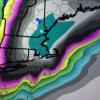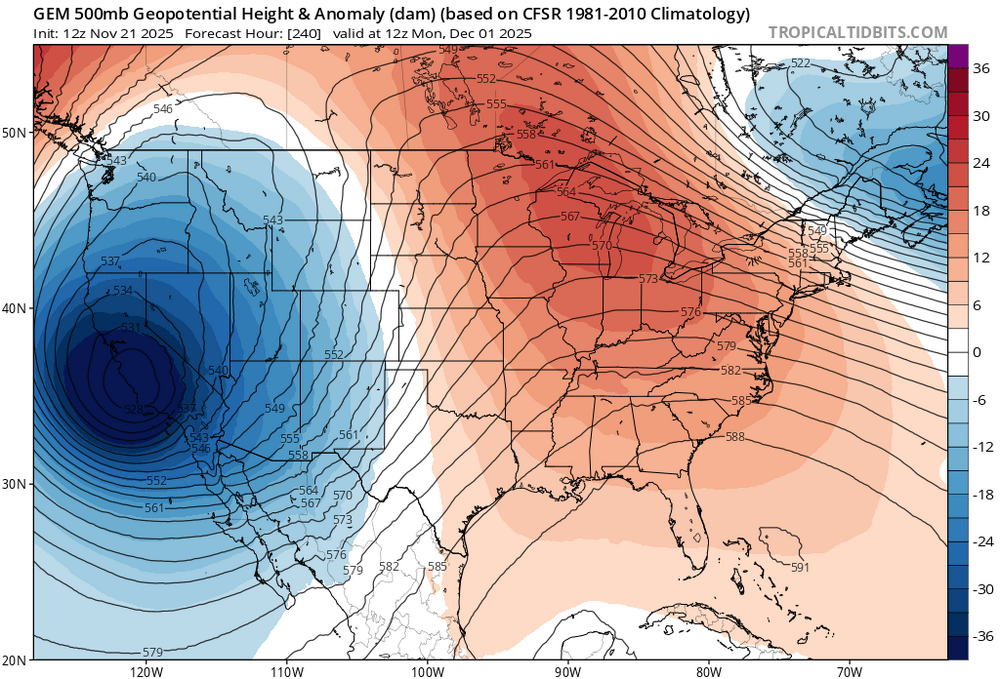All Activity
- Past hour
-

November 2025 general discussions and probable topic derailings ...
ORH_wxman replied to Typhoon Tip's topic in New England
Gonna be several shots at a SWFE i think in the first 10 days of Dec....pattern has that look. -

November 2025 general discussions and probable topic derailings ...
WinterWolf replied to Typhoon Tip's topic in New England
It might start catching on by next Wednesday. -
ChatGPT has some interesting theories to explain the repetitive ULLs following the CA coast. Its response was lengthy so I've summarized it below. I can't support or refute the validity of any of these potential mechanisms. ChatGPT further suggested that we are in a quasi-stable continental pattern. And in support of that, to my eye, the forecasted mean jet at day 15 does look roughly similar to its pattern and position over the past few days... Persistent Coastal Trough / Blocked Jet Stream A semi-stationary trough off the West Coast creates a “corridor” that repeatedly guides ULLs southward. Blocking patterns upstream (central/west Pacific ridging) prevent the flow from progressing eastward, so the same pathway persists. Cutoff Lows + Weak Steering Flow ULLs becoming cut off from the main jet move slowly and tend to drift along the coastline where steering currents are weak but coherent. Once one cutoff forms, subsequent ones often follow similar tracks. Coastal Waveguide Effect Sharp land–ocean contrasts and California’s north–south coastline help steer shallow upper-level systems parallel to the coast. The long coastline supports a “channeling” effect for southward-moving lows. North Pacific SST / PDO Influence Negative PDO–like SST patterns (colder near CA, warmer farther west) promote troughing off the West Coast. This anchors the mean storm-track/upper-level pattern in a coastal position. Weak La Niña Teleconnection Current La Niña is weak, so typical ENSO storm-track signals (often more northerly) are not dominant. With ENSO influence muted, other mid-latitude patterns can take over and become unusually persistent. Seasonal Transition Effects Autumn jet-stream reorganization makes the atmosphere more prone to amplified and sticky patterns. Early-season troughs are more likely to become cut off and recur along similar paths.
-

November 2025 general discussions and probable topic derailings ...
CoastalWx replied to Typhoon Tip's topic in New England
I’m gonna call BS on the GFS for T-Day. -
Fall 2025 Medium/Long Range Discussion
A-L-E-K replied to Chicago Storm's topic in Lakes/Ohio Valley
looking like some brief post turkey cad before we kick off december with an eastern ridge anything interesting still far off in no man's land -

November 2025 general discussions and probable topic derailings ...
WinterWolf replied to Typhoon Tip's topic in New England
Paging Proctologist Dr Kevin…. -

November 2025 general discussions and probable topic derailings ...
WinterWolf replied to Typhoon Tip's topic in New England
Like proctologist. -
November 2025 general discussions and probable topic derailings ...
ma blizzard replied to Typhoon Tip's topic in New England
cold airmass to the north at least gives us a shot .. not a bad look but prob would be better the more latitude you got -
But then there's this... The Madden Julian Oscillation or (MJO) is really important when it comes to long range forecasting during the winter. Thunderstorm convection initiating over various regions along the equator while simultaneously other regions are drier corresponds with a total of 8 phases we monitor that influence the weather patterns over various regions across the globe, including North America. When you have a lot of convection over phase 6 which is the Western Pacific, it likes to enhance a very warm pattern over much the US. Currently we are in a phase 6 and it’ll make sense to you if you have been outside today. When convection sets up a little further to the east over the Western Pacific, we call it a phase 7. That introduces more cold air back to the US, but is met with some resistance from a ridge of high pressure over the Southeast US that tries to keep this part of the country milder. As we head into Thanksgiving, we’ll see a brief shot of cold air for a few days, but going into early December it will be met with a return of that ridge which will again increase our temperatures for a time. When convection begins to shift into the Western Hemisphere, we call that phase 8. Phase 8 corresponds to cold overwhelming the pattern for the central and eastern US. The projected evolution of the MJO in the coming weeks is to go from 6 currently to 7 during the last week of November and early December and into phase 8 by mid December. Until that time our temperatures may be highly variable. Once we get into phase 8 mid-December, steadier cold air will become more predominant and winter weather chances will hopefully increase just in time for Christmas!
-
Wow that's an historic trof across the west coast on the 12z CMC in the long range. I've noticed ULLs are forming and deepening right along the west coast this fall and then tracking southward along the full length of the California coastline. If you loop 500mb it's been happening and is forecast to happen over and over. I feel like this tendency was noticed the past two winters. And sure, ULLs getting stuck in the southwest has been going on forever. But this recent propensity seems more pronounced and repetitive than in the past. Does anyone know why this is happening? Is it some kind of frictional effect or landmass-Ocean interface effect... maybe combined with Pacific Ocean temperatures and a strong Pac Jet? Or is this typical upper- & mid- level behavior and I've just never noticed it before?
-
To add: -1983 doesn’t fit -1985 strong 2nd half of Oct -1989 was fairly stout last 1/3 of Oct -2000 wasn’t strong but was stronger than avg
-
No real opinion on past MJO results, but that little loop right in 7 before 8 tells me that there might be a brief period of split forcing - one in 7/8 and the other in 3/4. That split forcing in 3/4 should get suppressed quickly and we get fully into 8.
-
That's because liquid precip and >32F temps are a guarantee for much of the year (hence "dog bites man" weather) throughout the Conus, save the higher elevations. But I know you know this!
-
Obviously I'm not a met, but my stance is the pattern begins to break down by mid month into Xmas...probably not "warm". I may have def. rushed that though given the weak antecedent nature of the PV in conjunction with the anticipated behavior of the MJO. Just don't be surprised to see the second half trend a bit warmer.
-

November 2025 general discussions and probable topic derailings ...
CoastalWx replied to Typhoon Tip's topic in New England
SWFE on 12/3? Decent NoP anyways. -

November 2025 general discussions and probable topic derailings ...
CoastalWx replied to Typhoon Tip's topic in New England
Nasty and wedgy on the gfs. Let’s either delay it or get it out sooner. -

December 2025 Short/Medium Range Forecast Thread
Carvers Gap replied to John1122's topic in Tennessee Valley
Very short post. The Baja low looks legit. It is still possible that is feedback, but unlikely since both the 12z CMC and GFS both have it. After the Thanksgiving cold snap, a standing wave will result due to the Baja low. That BL will pump a ridge over the eastern 2/3 of the United States w/ a rare Bermuda high set in place to start December. Record highs are possible over some portions of the SE. It will take some time to break all of that down. Right now, the bigger concern is that ensembles continue to hold the cold pattern in the d10-15 range as does LR ext modeling. This could be a delay in the overall cold pattern or it could mean that modeling is just wrong. Something is gonna have to give though. The MJO is set to rotate into cold phases. Either the MJO forecast plots are wrong OR modeling is simply not recognizing the MJO plot quite yet. Remember, sometimes modeling will not "see" MJO influence in the d10-15. I would guess we will see a very strong cold from around December 10th (edit...NOT d10), and that unleashes the cold into Lower 48 (east of the Rockies). Interestingly, I do believe the Euro Weeklies has developed a cold bias. I don't know if they tweaked something, but it seems to be the default in the week 3-6 range??? -
I'm not even sure if it's wise to look at outcomes that far back.
-
0z Euro was pretty cold for Thanksgiving weekend in NYC Mid 40s for Thanksgiving, low 40s for Black Friday, mid 30s for Saturday.
-

2025-2026 ENSO
40/70 Benchmark replied to 40/70 Benchmark's topic in Weather Forecasting and Discussion
This probably ties into the rule concerning the higher amplitude MJO waves in October preceding colder winters that @bluewavehas referenced, though I know that is a more recent phenomenon. I do wonder if those seasons were higher amplitude in October. Looks like 2010 would fit the mold...not so much 2005 and 2000. -
November 2025 general discussions and probable topic derailings ...
dryslot replied to Typhoon Tip's topic in New England
Nor should anyone else, A month away many things can change, I guess i somewhat understand the thinking if you compare that period to the past few years.










